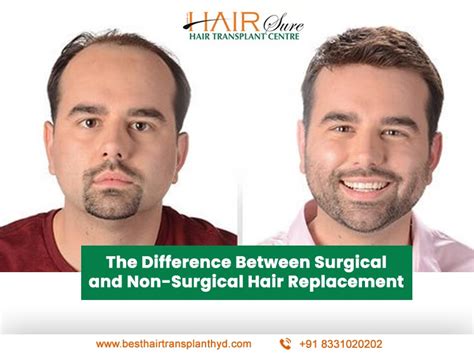Introduction
Hair loss, a prevalent issue affecting millions worldwide, can have a profound impact on one’s self-esteem and quality of life. While surgical hair restoration options exist, they often come with invasive procedures and hefty price tags. Fortunately, non-surgical hair replacement methods offer a wider range of accessible and cost-effective solutions that can restore hair volume and youthful vibrancy.

Types of Non-Surgical Hair Replacement
The burgeoning non-surgical hair replacement market offers a myriad of options to cater to diverse hair loss patterns and preferences.
-
Hair Toppers ($1,500-$5,000): These are partial hair pieces that conceal thinning areas or add volume to the crown. Toppers are typically made from human hair or synthetic fibers and can be clipped in or adhered with hair glue. They provide instant coverage and can be styled to blend seamlessly with natural hair.
-
Wigs ($1,000-$10,000): Wigs offer complete hair coverage and can provide a more comprehensive transformation. They come in a wide range of materials, styles, and colors to match the wearer’s natural hair texture and preferences. Wigs can be glued, sewn, or clipped into place, depending on the desired level of security.
-
Hair Extensions ($800-$3,000): Extensions add length, volume, or highlights to existing hair. They come in strands that are attached to the natural hair using various methods, such as clip-ins, fusion, or tape-ins. Extensions can be made from human hair or synthetic fibers and can last several months with proper care.
Benefits of Non-Surgical Hair Replacement
Non-surgical hair replacement methods offer a host of benefits over surgical options:
- Non-Invasive: No cutting or scarring of the scalp, eliminating downtime and minimizing risks.
- Reversibility: Easily removed or adjusted as desired, providing flexibility and peace of mind.
- Affordability: Generally more cost-effective than surgical procedures, making hair restoration accessible to a wider range of individuals.
- Natural-Looking Results: Advanced hair replacement techniques can achieve undetectable results that seamlessly blend with natural hair.
- Increased Confidence: Restored hair volume and thickness can significantly boost self-esteem and improve overall well-being.
Who Can Benefit from Non-Surgical Hair Replacement?
Non-surgical hair replacement methods are suitable for individuals facing various types of hair loss, including:
- Androgenetic Alopecia (Male/Female Pattern Baldness): The most common type of hair loss, caused by genetic factors and hormonal changes.
- Alopecia Areata: An autoimmune condition that causes patchy hair loss.
- Telogen Effluvium: Diffuse hair thinning due to stress, illness, or hormonal imbalances.
- Medical Conditions: Hair loss associated with cancer treatments, thyroid disorders, or autoimmune diseases.
- Aesthetic Preferences: Individuals who desire thicker, fuller hair or a change in hairstyle without resorting to surgical procedures.
Choosing the Right Non-Surgical Hair Replacement Method
Selecting the most appropriate non-surgical hair replacement method depends on individual needs, hair loss pattern, and lifestyle. Factors to consider include:
- Type of Hair Loss: Different methods are more suitable for specific types of hair loss.
- ** desired Coverage:** The extent of hair loss and desired level of coverage should influence the choice of hair replacement method.
- Maintenance and Cost: Non-surgical hair replacement methods require varying levels of maintenance and come with different price points.
- Lifestyle and Personal Preferences: Choose a method that fits well with daily routines and personal preferences.
Trends and Innovations in Non-Surgical Hair Replacement
The non-surgical hair replacement industry is constantly evolving, introducing innovative techniques and materials to enhance results and meet evolving needs.
- 3D Printing: 3D-printed hairpieces offer personalized solutions based on individual head shapes and hair growth patterns.
- Biomimetic Hair: Synthetic hair fibers that mimic the natural structure and properties of human hair, providing more realistic results.
- Improved Bonding Techniques: Advancements in bonding technology ensure secure and comfortable attachment of hair replacement pieces.
- Virtual Consultations: Online platforms allow individuals to connect with hair replacement experts remotely for personalized recommendations.
Conclusion
Non-surgical hair replacement has become an increasingly popular and accessible option for individuals facing hair loss. With a wide range of methods available, personalized solutions can be tailored to meet specific needs, improve hair health, and boost confidence. As the industry continues to innovate, the future of hair replacement holds promising advancements for optimal hair restoration.
-
Can non-surgical hair replacement look natural? Yes, advanced hair replacement techniques can achieve undetectable results that seamlessly blend with natural hair.
-
How long do non-surgical hair replacement methods last? Depending on the method chosen, hair replacements can last from a few weeks to several months with proper maintenance.
-
Is non-surgical hair replacement comfortable to wear? Yes, most non-surgical hair replacement methods are designed for comfort and can be worn for extended periods without irritation.
-
Can I style my non-surgical hair replacement? Yes, you can style hair replacements using heat tools, curlers, or hair products, just as you would with natural hair.
-
How much does non-surgical hair replacement cost? Costs vary depending on the method, materials used, and maintenance required. Toppers typically range from $1,500-$5,000, wigs from $1,000-$10,000, and extensions from $800-$3,000.
-
How do I choose the right non-surgical hair replacement method for me? Consult with a hair restoration expert to determine the best method based on your hair loss type, desired coverage, and lifestyle.
-
Are non-surgical hair replacement methods safe? Yes, non-surgical methods are generally safe and non-invasive, with no cutting or scarring involved.
-
Can I swim or exercise with my non-surgical hair replacement? Some hair replacement methods are water-resistant and can be worn during swimming or exercise, while others should be removed beforehand. Consult with your hair replacement specialist for specific instructions.
